绝佳幼儿英语学习阶梯英语课程单元07
- 格式:doc
- 大小:7.17 MB
- 文档页数:49
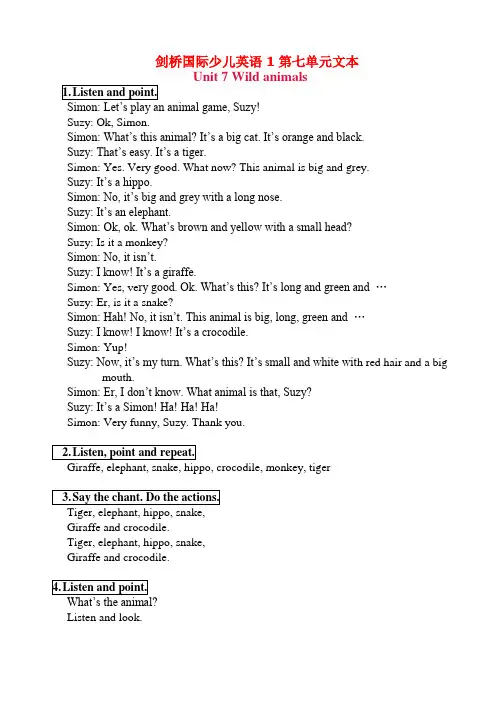
剑桥国际少儿英语1第七单元文本Unit 7 Wild animalsSuzy: Ok, Simon.Simon: What’s this animal? It’s a big cat. It’s orange and black.Suzy: That’s easy. It’s a tiger.Simon: Yes. Very good. What now? This animal is big and grey.Suzy: It’s a hippo.Simon: No, it’s big and grey with a long nose.Suzy: It’s an elephant.Simon: Ok, ok. What’s brown and yellow with a small head?Suzy: Is it a monkey?Simon: No, it isn’t.Suzy: I know! It’s a giraffe.Simon: Yes, ve ry good. Ok. What’s this? It’s long and green and …Suzy: Er, is it a snake?Simon: Hah! No, it isn’t. This animal is big, long, green and …Suzy: I know! I know! It’s a crocodile.Simon: Yup!Suzy: Now, it’s my turn. What’s this? It’s small and white wit h red hair and a big mouth.Simon: Er, I don’t know. What animal is that, Suzy?Suzy: It’s a Simon! Ha! Ha! Ha!Simon: Very funny, Suzy. Thank you.Giraffe and crocodile.Tiger, elephant, hippo, snake,Giraffe and crocodile.Listen and look.Point to the animal in this book.It’s small and brown.It’s long and gre en.It’s grey and dirty.It’s big and clean.It’s orange and black.It’s red and blue.It’s yellow and brown with a small head too.Come alive.Walk and talk.On the count of five.One, two, three, four, five.Maskman: What have you got there, Trevor?Trevor: I’ve got a book on animals. Look at these monkeys. They are funny. Maskman: Yes, they’ve got long arms and big hands. Oooh. What are they? Trevor: They are crocodiles. They are long and green and they’ve got b ig mouths and long tails.Monty: How many teeth have they got?Trevor: They’ve got a lot of teeth.Maskman: Have they got long legs?Trevor: No, they haven’t. They’ve got short legs and feet.Look at the snakes. They’ve got no legs and no feet.Maskman: Look at the elephants. They are big and grey.They’ve got very big ears, long noses and short tails.Monty: Hmmm. Elephants. They’re my favorite animals.They’ve got short legs.They’ve got long legs.They haven’t got feet.Animals, animals, short and tall.Animals, animals, dirty and clean.Animals, animals, brown and green.Come on children, sing along.Sing and move to the animal song.Le t’s all do the hippo show.Let’s all do the hippo showLet’s all do the hippo showMove your hands and feet.Let’s all do the elephant dance.Let’s all do the elephant dance.Move your arms and legs.Let’s all do the snake shake.Move your head and tail.L et’s all do the crocodile smile.Let’s all do the crocodile smile.Let’s all do the crocodile smile.Show your big white teeth.Let’s all do the giraffe laugh.Let’s all do the giraffe laugh.Let’s all do the giraffe laugh.Open your big clean mouth.Car, computer, crocodile, catCar, computer, crocodile, catCome alive.Walk and talk.On the count of five.One, two, three, four, five.Monty: Animals, animals, big and small. Animals, animals, short and tall. Marie: Help! Help, Maskman! Look at these snakes. They’re long and ugly and they’ve got two long teeth.Maskman: I’m here, Maree. I’ve got the snakes. Snakes have got two long teeth, but I’ve got two big arms.Marie: Ooohh, Maskman, thank you. You are a superhero.Trevor: Help! Help! Help, Maskman! Look at these crocodiles. They’ve got big mouths and they’ve got a lot of teeth.Maskman: I’ m here, Trevor. I’ve got the crocodiles. Crocodiles have got big mo uths and a lot of teeth, but I’ve got long legs and big hands. Trevor: Ooohh, Maskman, thank you. You are a superhero.Maskman: Help! Help! Look at these elephants. They are very big. And they’ve got very big feet. Aaaagghh!Monty: I’m here, Maskman! Elephants are very big and they’ve got very big feet, but I’m a mouse, I’m very small.Maskman, Trevor, Marie: Thank you,Monty. You are a small mouse, but you are a superhero.。
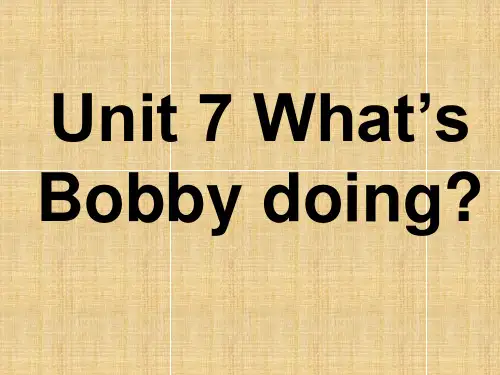
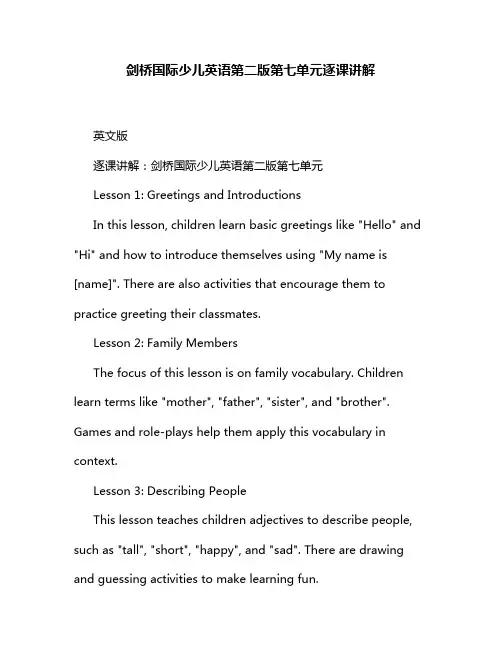
剑桥国际少儿英语第二版第七单元逐课讲解英文版逐课讲解:剑桥国际少儿英语第二版第七单元Lesson 1: Greetings and IntroductionsIn this lesson, children learn basic greetings like "Hello" and "Hi" and how to introduce themselves using "My name is [name]". There are also activities that encourage them to practice greeting their classmates.Lesson 2: Family MembersThe focus of this lesson is on family vocabulary. Children learn terms like "mother", "father", "sister", and "brother". Games and role-plays help them apply this vocabulary in context.Lesson 3: Describing PeopleThis lesson teaches children adjectives to describe people, such as "tall", "short", "happy", and "sad". There are drawing and guessing activities to make learning fun.Lesson 4: Colors and ShapesChildren learn basic colors like "red", "blue", "yellow", and shapes like "circle", "square", and "triangle". They engage in coloring and shape-sorting activities.Lesson 5: Numbers and CountingThe focus of this lesson is on counting from 1 to 10. Children practice counting objects and complete number-related activities.Lesson 6: Daily ActivitiesChildren learn about daily routines like waking up, brushing teeth, going to school, and playing. They participate in role-plays and storytelling to practice this vocabulary.Lesson 7: AnimalsThis lesson introduces common animals like "cat", "dog", "lion", and "elephant". Children engage in animal-themed games and crafts.Lesson 8: Review and RevisionThis lesson is a review of all the units learned in this book. Children participate in fun activities that consolidate their learning and prepare them for the next level.中文版剑桥国际少儿英语第二版第七单元逐课讲解第1课:问候与介绍在这堂课中,孩子们学习基本的问候语,如“你好”和“嗨”,以及如何用“我叫[名字]”来介绍自己。
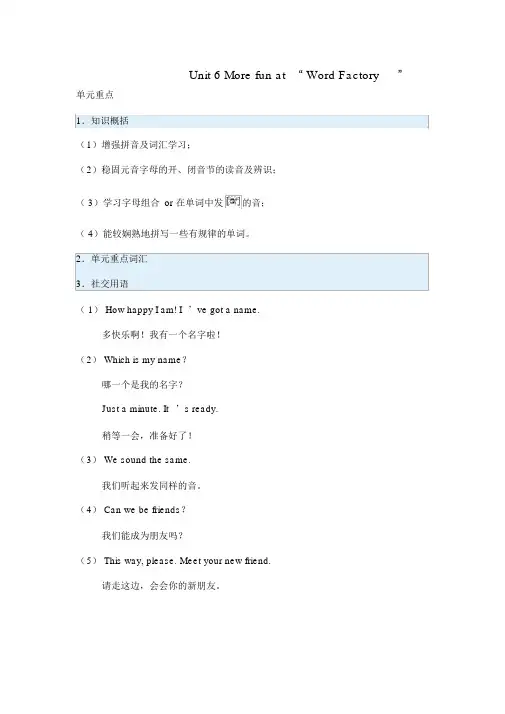
Unit 6 More fun at“ Word Factory”单元重点1.知识概括(1)增强拼音及词汇学习;(2)稳固元音字母的开、闭音节的读音及辨识;( 3)学习字母组合or 在单词中发的音;( 4)能较娴熟地拼写一些有规律的单词。
2.单元重点词汇3.社交用语( 1) How happy I am! I’ve got a name.多快乐啊!我有一个名字啦!(2) Which is my name?哪一个是我的名字?Just a minute. It’s ready.稍等一会,准备好了!(3) We sound the same.我们听起来发同样的音。
(4) Can we be friends?我们能成为朋友吗?(5) This way, please. Meet your new friend.请走这边,会会你的新朋友。
Period 1 —Period 21.复习(1) Words and expressions:(2) Sentences:Please look carefully and write their names in the boxes.请认真察看,把它们的名字写在盒子里。
I can write“ T”.我能写“T。
”You want it. You say it and then you get it.你要它,你说它而后你就能获得它。
Aa is for an apple.Aa 代表一个苹果。
(3) Pronunciation:字母组合 ir 在重读音节中发的音,发时嘴型扁平,上下齿轻轻张开,舌身放平,舌中部轻轻抬起。
2.重难点知识解说①Words and expressions:②Bee: How happy I am! I’ ve got a name.多快乐啊!我有一个名字啦!Plane:Which is my name?哪一个是我的名字?Bird :Just a minute. It’ s ready.稍等一会,准备好了!Worker: Oh, another bad name.噢!又一个错误名!③Same family word. This way, please.同一家庭单词,请往这边走。
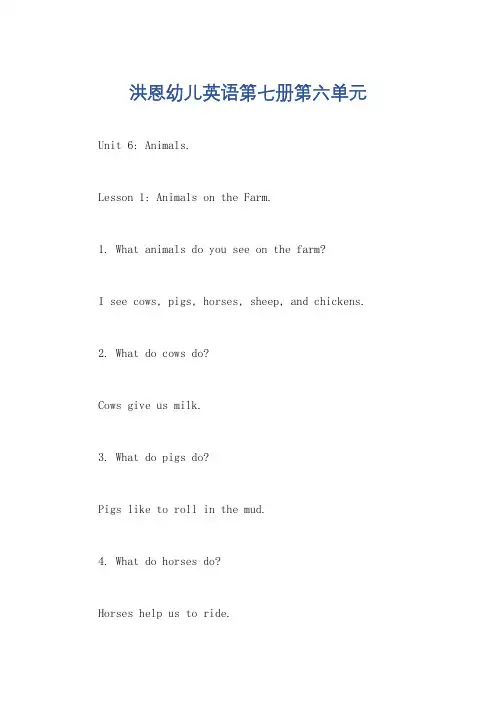
洪恩幼儿英语第七册第六单元 Unit 6: Animals.Lesson 1: Animals on the Farm.1. What animals do you see on the farm?I see cows, pigs, horses, sheep, and chickens.2. What do cows do?Cows give us milk.3. What do pigs do?Pigs like to roll in the mud.4. What do horses do?Horses help us to ride.5. What do sheep do?Sheep give us wool.6. What do chickens do?Chickens give us eggs.Lesson 2: Animals in the Zoo.1. What animals do you see at the zoo?I see lions, elephants, tigers, monkeys, and giraffes.2. What do lions do?Lions roar loudly.3. What do elephants do?Elephants have long trunks.4. What do tigers do?Tigers have sharp claws.5. What do monkeys do?Monkeys swing from the trees.6. What do giraffes do?Giraffes have long necks.Lesson 3: Animals in the Sea.1. What animals do you see in the sea?I see fish, turtles, dolphins, sharks, and whales.2. What do fish do?Fish swim in the water.3. What do turtles do?Turtles have shells.4. What do dolphins do?Dolphins jump out of the water.5. What do sharks do?Sharks have sharp teeth.6. What do whales do?Whales are very big.Lesson 4: Animals in the Air.1. What animals do you see in the air?I see birds, bats, and butterflies.2. What do birds do?Birds fly in the sky.3. What do bats do?Bats fly at night.4. What do butterflies do?Butterflies have colorful wings. Lesson 5: Animal Sounds.1. What sound does a cow make?A cow makes a "moo" sound.2. What sound does a pig make?A pig makes an "oink" sound.3. What sound does a horse make?A horse makes a "neigh" sound.4. What sound does a sheep make?A sheep makes a "baa" sound.5. What sound does a chicken make?A chicken makes a "cluck" sound.6. What sound does a lion make?A lion makes a "roar" sound.7. What sound does an elephant make? An elephant makes a "trumpet" sound.8. What sound does a tiger make?A tiger makes a "growl" sound.9. What sound does a monkey make?A monkey makes a "chat" sound.10. What sound does a giraffe make?A giraffe makes a "hiss" sound.11. What sound does a fish make?A fish makes a "splash" sound.12. What sound does a turtle make?A turtle makes a "click" sound.13. What sound does a dolphin make?A dolphin makes a "whistle" sound.14. What sound does a shark make?A shark makes a "chomp" sound.15. What sound does a whale make?A whale makes a "sing" sound.16. What sound does a bird make?A bird makes a "chirp" sound.17. What sound does a bat make?A bat makes a "squeak" sound.18. What sound does a butterfly make?A butterfly makes a "flutter" sound.。
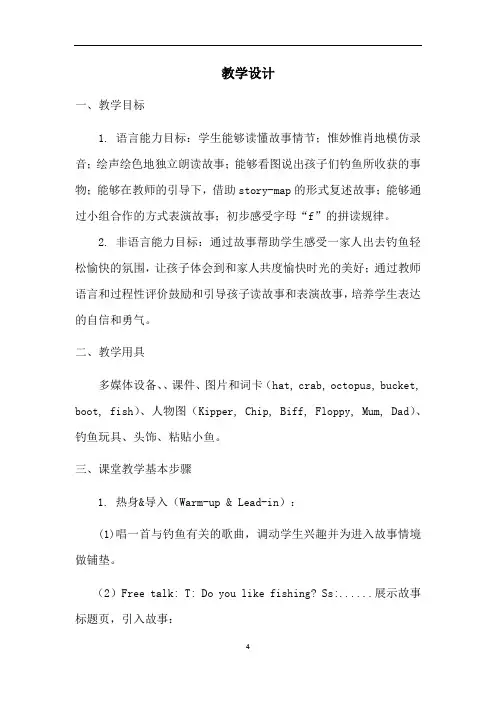
教学设计一、教学目标1. 语言能力目标:学生能够读懂故事情节;惟妙惟肖地模仿录音;绘声绘色地独立朗读故事;能够看图说出孩子们钓鱼所收获的事物;能够在教师的引导下,借助story-map的形式复述故事;能够通过小组合作的方式表演故事;初步感受字母“f”的拼读规律。
2. 非语言能力目标:通过故事帮助学生感受一家人出去钓鱼轻松愉快的氛围,让孩子体会到和家人共度愉快时光的美好;通过教师语言和过程性评价鼓励和引导孩子读故事和表演故事,培养学生表达的自信和勇气。
二、教学用具多媒体设备、、课件、图片和词卡(hat, crab, octopus, bucket, boot, fish)、人物图(Kipper, Chip, Biff, Floppy, Mum, Dad)、钓鱼玩具、头饰、粘贴小鱼。
三、课堂教学基本步骤1. 热身&导入(Warm-up & Lead-in):(1)唱一首与钓鱼有关的歌曲,调动学生兴趣并为进入故事情境做铺垫。
(2)Free talk: T: Do you like fishing? Ss:......展示故事标题页,引入故事:Kipper’s family went fishing. What did they get? Let’s learn the new story Funny Fish.教师带读Funny Fish,并带学生读:f-f-f-funny, f-f-f-fish,初步感受/f/的拼读规律,。
2. 看图讲故事(Storytelling):理解故事情节,观察一家人钓鱼的过程和收获,感受其中的乐趣教师利用课件逐幅播放故事图片,并用丰富的表情、生动的英文和适当的肢体语言给学生绘声绘色地讲故事,让学生观察一家人钓鱼的过程和收获,体会这其中的乐趣。
(Picture 1)Look, who are they?Mum, Dad, Biff, Chip, Kipper and Floppy.What were they doing?They were going fishing.(Picture 2)Look! Kipper was fishing.Would he get a fish?(Picture 3)What did he get?Aha, he got a hat.Look at Floppy! (教师模仿Floppy的表情并引导学生观察图片)(Picture 4)Biff was fishing.She got a crab. Oh, look! What was under the bridge?(引导学生观察图片后自由作答)It was an octopus. Chip was fishing. Would he geta fish?(Picture 5)Look! Oh, no! He got an octopus. (引导学生观察图片)Everyone laughed.Look at Mum. Would she get a fish? (引导学生观察妈妈的表情)(Picture 6)Oh, no! What did Mum get?Mum got a bucket. (模仿妈妈的表情并引导观察图片)What bad luck!(Picture 7)Dad was fishing.Would he get a fish?Everyone expected. (做出期待的表情并引导学生观察图片)(Picture 8)Oh, no! What did Dad get?Dad got a boot.Look at the children and Mum. Why were they soworried? (引导学生观察人物表情)What would happen?(Picture 9)Oops, the boot hit Floppy.SPLASH! Floppy fell in the water. (配合动作表情)Would Floppy die?(引导学生猜测故事)(Picture 10)Let’s look! Aha, Floppy got a fish. (指向图片)Everyone laughed. (配合动作表情)3. 听录音模仿(Listening and Imitating):听懂录音并模仿出标准的语音语调(1)让学生完整地听一遍故事,整体输入。
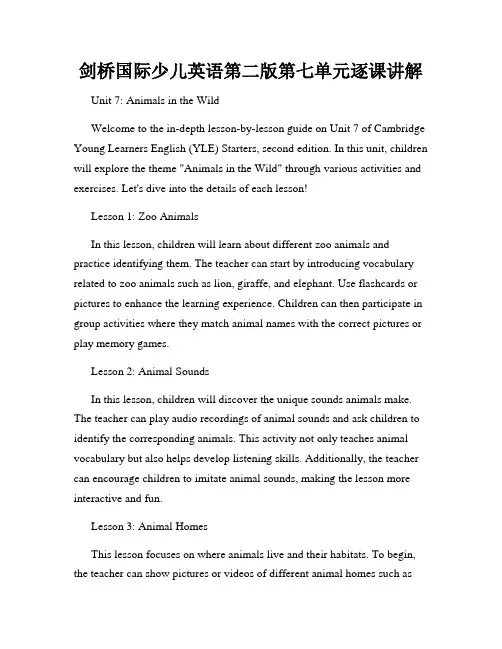
剑桥国际少儿英语第二版第七单元逐课讲解Unit 7: Animals in the WildWelcome to the in-depth lesson-by-lesson guide on Unit 7 of Cambridge Young Learners English (YLE) Starters, second edition. In this unit, children will explore the theme "Animals in the Wild" through various activities and exercises. Let's dive into the details of each lesson!Lesson 1: Zoo AnimalsIn this lesson, children will learn about different zoo animals and practice identifying them. The teacher can start by introducing vocabulary related to zoo animals such as lion, giraffe, and elephant. Use flashcards or pictures to enhance the learning experience. Children can then participate in group activities where they match animal names with the correct pictures or play memory games.Lesson 2: Animal SoundsIn this lesson, children will discover the unique sounds animals make. The teacher can play audio recordings of animal sounds and ask children to identify the corresponding animals. This activity not only teaches animal vocabulary but also helps develop listening skills. Additionally, the teacher can encourage children to imitate animal sounds, making the lesson more interactive and fun.Lesson 3: Animal HomesThis lesson focuses on where animals live and their habitats. To begin, the teacher can show pictures or videos of different animal homes such asnests, burrows, and caves. Children can work in pairs or small groups to match animals with their appropriate habitats. This activity promotes critical thinking and encourages children to learn about animals in their natural environments.Lesson 4: Animal Body PartsIn this lesson, children will learn about the different body parts of animals. The teacher can use visual aids to introduce vocabulary related to animal body parts, such as wings, fins, and tails. Children can then participate in interactive activities, like labeling animal diagrams or playing "Simon Says" to mimic animal movements. These activities not only teach vocabulary but also promote physical coordination.Lesson 5: Animal ActionsThis lesson focuses on the actions animals perform. The teacher can use pictures or videos to showcase animal behaviors like running, swimming, or flying. Children can imitate these actions individually or in pairs, promoting physical movement and enhancing vocabulary retention. Additionally, the teacher can organize a game of charades where children act out animal actions for others to guess.By following this lesson-by-lesson guide, teachers can effectively deliver Unit 7 of the Cambridge YLE Starters, second edition, ensuring an engaging and comprehensive learning experience for young learners. Remember to tailor the activities to suit the specific needs and language level of your students. Enjoy teaching "Animals in the Wild" and watch your students' English skills flourish!。
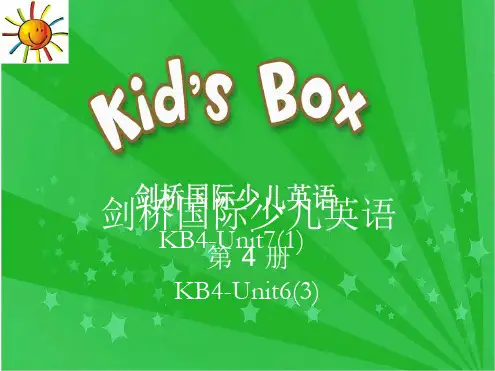

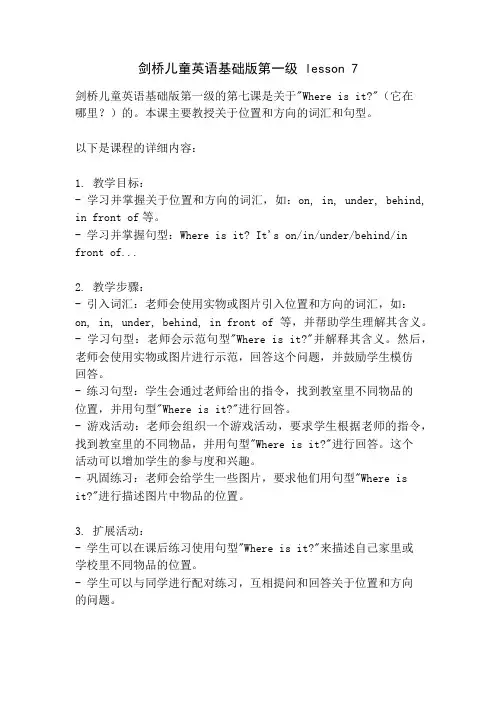
剑桥儿童英语基础版第一级 lesson 7剑桥儿童英语基础版第一级的第七课是关于"Where is it?"(它在哪里?)的。
本课主要教授关于位置和方向的词汇和句型。
以下是课程的详细内容:1. 教学目标:- 学习并掌握关于位置和方向的词汇,如:on, in, under, behind, in front of等。
- 学习并掌握句型:Where is it? It's on/in/under/behind/in front of...2. 教学步骤:- 引入词汇:老师会使用实物或图片引入位置和方向的词汇,如:on, in, under, behind, in front of等,并帮助学生理解其含义。
- 学习句型:老师会示范句型"Where is it?"并解释其含义。
然后,老师会使用实物或图片进行示范,回答这个问题,并鼓励学生模仿回答。
- 练习句型:学生会通过老师给出的指令,找到教室里不同物品的位置,并用句型"Where is it?"进行回答。
- 游戏活动:老师会组织一个游戏活动,要求学生根据老师的指令,找到教室里的不同物品,并用句型"Where is it?"进行回答。
这个活动可以增加学生的参与度和兴趣。
- 巩固练习:老师会给学生一些图片,要求他们用句型"Where is it?"进行描述图片中物品的位置。
3. 扩展活动:- 学生可以在课后练习使用句型"Where is it?"来描述自己家里或学校里不同物品的位置。
- 学生可以与同学进行配对练习,互相提问和回答关于位置和方向的问题。
以上就是剑桥儿童英语基础版第一级第七课的详细内容。
希望对你有所帮助!。
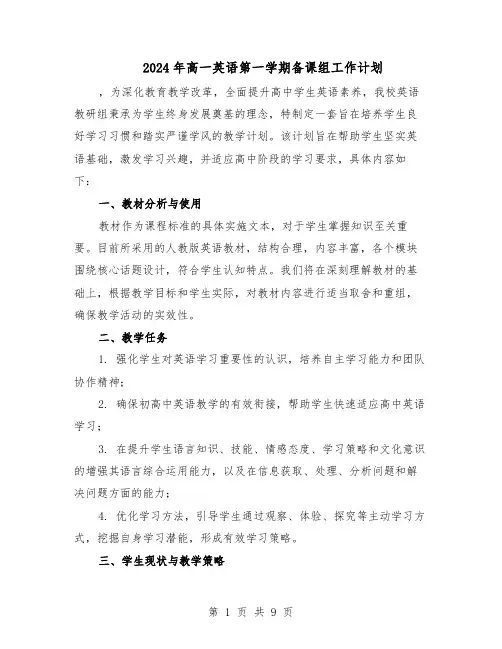
2024年高一英语第一学期备课组工作计划,为深化教育教学改革,全面提升高中学生英语素养,我校英语教研组秉承为学生终身发展奠基的理念,特制定一套旨在培养学生良好学习习惯和踏实严谨学风的教学计划。
该计划旨在帮助学生坚实英语基础,激发学习兴趣,并适应高中阶段的学习要求,具体内容如下:一、教材分析与使用教材作为课程标准的具体实施文本,对于学生掌握知识至关重要。
目前所采用的人教版英语教材,结构合理,内容丰富,各个模块围绕核心话题设计,符合学生认知特点。
我们将在深刻理解教材的基础上,根据教学目标和学生实际,对教材内容进行适当取舍和重组,确保教学活动的实效性。
二、教学任务1. 强化学生对英语学习重要性的认识,培养自主学习能力和团队协作精神;2. 确保初高中英语教学的有效衔接,帮助学生快速适应高中英语学习;3. 在提升学生语言知识、技能、情感态度、学习策略和文化意识的增强其语言综合运用能力,以及在信息获取、处理、分析问题和解决问题方面的能力;4. 优化学习方法,引导学生通过观察、体验、探究等主动学习方式,挖掘自身学习潜能,形成有效学习策略。
三、学生现状与教学策略鉴于学生构成的多样性,英语教学将采取分层次教学策略,对创新班、重点班和普通班分别制定适宜的教学计划和重点。
普通班重视基础知识教学,创新班则在此基础上,加强阅读和写作能力的培养。
四、教学内容与进度本学期将完成人教新课标版必修一五个单元和必修二四个单元的教学任务。
辅助教学材料包括《同步作业本》、《高中教学英语阶梯听力》、《优化学案》等,创新班将额外使用《阅读理解天天练》及教师自编导学案。
五、工作措施1. 开展集体备课,集思广益,确保教学内容和方法的科学性和创新性;2. 加强单词默写,提高学生词汇量,通过定期默写检测,巩固学习成果;3. 推进全员赛课活动,促进教师间的相互学习和教学研究,提升教学质量。
通过以上措施,我们期望能够为学生营造一个充满活力、富有成效的英语学习环境。
小学英语“阶梯式”写作教学策略的研究与实践写作是一种人类表达情绪的有效途径,也是我们沟通的一种重要工具。
在新课程改革的大环境下,我们倡导将学生的基本核心素质与课程相结合,教师在教学时要更加关注小学生的写作能力。
英语的核心素质也包含了提高学生的写作和语言使用能力的要求。
一、现阶段小学英语写作教学中的问题(一)教师和学生对写作的重视程度不足写作是一种综合的思维活动。
在学生写作能力的培养过程中,我们会遇到许多难题,因此,教师要抓好学生的基础,在小学阶段就要对学生的写作能力多加重视。
英语写作课由于学习难度大,成绩提高并不明显,以至于老师、学生对写作的重视程度越来越低。
很多学生写作时只是机械地背写出一些例句,并没有充分调动自己所学的知识,而是进行机械性复制,没有体现出他们对于作文框架的整体构思和整体认知,在进行表达时也经常利用中文叙述方式进行英文词语组织。
这就表示学生没有掌握正确的英语表达方式,造成了英语作文中的“无语”。
从当前的英语教育现状看,在现阶段的英语课堂上,老师常常只是进行听力和口语练习,忽略了写作能力的培养,缺少与之配套的教学,在写作教学上没有进行创造性的尝试,单调乏味的写作课不能引起学生的兴趣。
(二)英语写作教学没有针对性小学生对英语的认识尚属起步阶段,提高学生英语能力并非一蹴而就。
在写作教学的过程中,在一学期的教学完成之后还有部分学生缺乏词汇和语法的知识储备量,导致他们的文章逻辑不完整,写出来的文章很难读懂。
最主要的原因就是学生的基础不扎实,学生跟不上教师的教学步伐,教师在教学时出现赶进度的情况。
教师按部就班教学生学习单词、课文和语法,最后让学生仿写作文,大大削弱了学生们的参与度,在教学时也没有考虑到部分困难生跟不上的问题,教学没有针对化。
(三)作文评估机制不能激励学生的写作积极性在英语写作中,学生写作能力很关键,老师对学生作文水平的评价作用也不容忽视。
合理科学的评价对于改正他们的写作失误、提高学生的自信心有很大的意义。
洪恩幼儿英语升级版第一册第七单元【导语】洪恩幼儿英语是一套为3-6岁幼儿设计的英语学习教材,其升级版第一册第七单元是该教材中的重要部分。
本文将围绕第七单元的主题展开详细的分析和讨论,旨在帮助读者更好地了解该教材,并且探讨如何在教学实践中更好地利用这一单元。
【一、单元主题】第一册第七单元的主题是“Happy Halloween”。
这个主题紧贴幼儿的生活实际,同时又融合了西方传统文化节日,可以激发幼儿的学习兴趣,帮助他们学习英语的同时了解不同的文化。
【二、单元内容】1. 词汇学习第七单元中涉及了一些与Halloween有关的词汇,如pumpkin, ghost, witch, candy, costume等。
通过这些词汇的学习,幼儿可以了解Halloween的一些常见元素,并且在学习外语的过程中培养对异国文化的好奇心。
2. 句型构建在这一单元中,还会学习一些关于Halloween的句型,比如“What do you want to be for Halloween?”、“I want to be a witch.”等。
这些句型的学习有助于幼儿在日常生活中灵活运用所学的句型,提高他们的口语表达能力。
3. 歌曲和游戏为了更好地激发幼儿的学习兴趣,第七单元还会引入一些与Halloween相关的歌曲和游戏,比如唱歌《Trick or Treat》和进行一些简单的角色扮演游戏。
这些歌曲和游戏既可以加强幼儿对于Halloween主题内容的记忆,又可以通过歌曲和游戏培养幼儿的音乐和表演能力。
【三、教学实践】1. 创设情景在教学实践中,可以通过创设Halloween的情景来帮助幼儿更好地学习与运用所学的知识。
可以准备一些Halloween的装饰物,如南瓜灯、面具等,让幼儿在这种情景中学习相应的词汇、句型等。
2. 进行小组讨论可以组织幼儿进行小组讨论,让他们谈谈自己对Halloween的理解,以及想要在这一节日中扮演什么样的角色,这样可以促进幼儿围绕Halloween的主题进行英语交流。
阶梯快乐儿童英语家庭联络簿My name is ______________My class is _______________梅山剑桥英语培训中心Meishan Cambridge English Training Center进度安排学习重点上课表现课程单元Level 1- Lesson 1I Am Jack 主题:人际关系(家庭成员)单词:father , cat, I, mother, dog常用语:Hi. / Hello. /How are you?自然拼音Phonics 1认识字母Aa-Bb英语儿歌How are you家庭作业:抄写字母及单词第二次进度安排学习重点上课表现课程单元Level 1- Lesson 1I Am Jack 主题:人际关系(家庭成员)课文自然拼音Phonics 1认识字母Cc-Dd英语儿歌How are you家庭作业:抄写字母及背诵课文进度安排学习重点上课表现课程单元Level 1- Lesson2It's a Nice Day 主题:人际关系(问候)单词:you, she, he, bird, cap常用语:Good morning./ Thank you./ What a nice day!/ It's a nice day!自然拼音Phonics 1认识字母Ee-Ff英语儿歌How are youIt's a nice day家庭作业:抄写字母及单词第四次进度安排学习重点上课表现课程单元Level 1- Lesson2It's a Nice Day 主题:人际关系(问候)课文自然拼音Phonics 1认识字母Gg-Hh英语儿歌It's a nice day家庭作业:抄写字母及背诵课文进度安排学习重点上课表现课程单元Level 1- Lesson3This is ourclassroom 主题:在学校(老师和学生)单词:teacher, classroom, stand up, sit down, student常用语:Good morning./ Stand up, please./ Please sit down./ What's your name?自然拼音Phonics 1认识字母Ii -Jj英语儿歌Good morning家庭作业:抄写字母及单词第六次进度安排学习重点上课表现课程单元Level 1- Lesson3This is ourclassroom 主题:在学校(老师和学生)课文自然拼音Phonics 1认识字母Kk- Ll英语儿歌Good morning家庭作业:抄写字母及背诵课文进度安排学习重点上课表现课程单元Level 1- Lesson4What's your name? 主题:认识事物(卧室)单词:desk, chair, book, pen, pencil box常用语:What's your name?/ Nice to meet you./ Nice to meet you, too./ How are you? Fine, thank you. And you?/ I'm fine.自然拼音Phonics 1认识字母M m-Nn英语儿歌What's this?家庭作业:抄写字母及单词第八次进度安排学习重点上课表现课程单元Level 1- Lesson4What's your name? 主题:认识事物(卧室)课文自然拼音Phonics 1认识字母Oo-Pp英语儿歌What's this?家庭作业:抄写字母及背诵课文进度安排学习重点上课表现课程单元Level 1- Lesson5Good morning 主题:我的家(卧室)单词:bed, sheet, pillow, blanket, bedroom常用语:Wake up!/ Good morning.It's time to get up!自然拼音Phonics 1认识字母Qq- Rr英语儿歌What do you see inthe bedroom?家庭作业:抄写字母及单词第十次进度安排学习重点上课表现课程单元Level 1- Lesson5Good morning 主题:我的家(卧室)课文自然拼音Phonics 1认识字母Ss-Tt英语儿歌What do you see inthe bedroom?家庭作业:抄写字母及背诵课文进度安排学习重点上课表现课程单元复习第一册自然拼音英语儿歌家庭作业:第十二次进度安排学习重点上课表现课程单元Level 2- Lesson1There are fivebooks 主题:数字(1~5)单词:one, two, three, four, five常用语:Wow!/ So...自然拼音Phonics 1认识字母Uu-Vv英语儿歌Numbers one tofive家庭作业:抄写字母及单词进度安排学习重点上课表现课程单元Level 2- Lesson1There are fivebooks 主题:数字(1~5)课文自然拼音Phonics 1认识字母Ww-Xx英语儿歌In the living room家庭作业:抄写字母及背诵课文第十四次进度安排学习重点上课表现课程单元Level 2- Lesson2In the living room 主题:我的家(客厅)单词:sofa,clock,curtain, window, living room常用语:Please close the window./ Are you OK?/ OK.自然拼音Phonics 1认识字母Yy-Zz英语儿歌In the living room家庭作业:抄写字母及背诵课文进度安排学习重点上课表现课程单元Level 2- Lesson2In the living room 主题:我的家(客厅)课文自然拼音Phonics 1复习字母Aa 及自然拼音单词英语儿歌In the living room家庭作业:抄写字母及背诵课文第十六次进度安排学习重点上课表现课程单元Level 2- Lesson3In the bathroom 主题:我的家(浴室)单词:bathroom, bathtub, sink, toothbrush, toothpaste 常用语:How are you?/ I'm fine, thank you. And you?/ Niceto meet you./ Nice to meet you,too./ I'm coming!自然拼音Phonics 1复习字母Bb及自然拼音单词英语儿歌I'm ready now!家庭作业:抄写自然拼音单词第十七次进度安排学习重点上课表现课程单元Level 2- Lesson3In the bathroom 主题:我的家(浴室)课文自然拼音Phonics 1复习字母Cc 及自然拼音单词英语儿歌I'm ready now!家庭作业:抄写自然拼音单词及背诵课文。